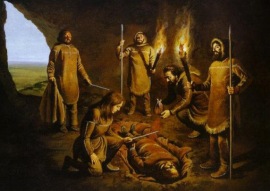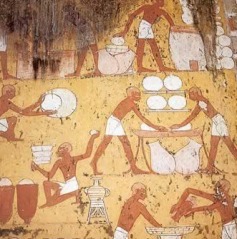As this is our first expedition into the excavation of food and cooking, I thought it best to build our foundation on what might be considered the cornerstone of true baking as we know it. Often cited as the most frequently eaten food item in nearly every culture (both modern and ancient), bread has long established itself as a true necessity in every kitchen. But for all the credit we give to this versatile, delicious, and (when prepared well) soul-satisfying food-staple, I believe most of us (myself included) take bread’s journey for granted. For when we look deeper at bread’s history, the lovable loaf becomes far more interesting than the sum of its ingredients.
The Lore of the Loaf
While it may seem as though bread simply appears on our grocery store shelves every week, our modern method of seemingly instant and reliable bread production belies the accidental and unpredictable origins that faced the pre-historic loaf.
Bread’s beginnings, while difficult to solidly determine, seem to reside in the middle of the Upper
Paleolithic age in Europe, roughly 30,000 years ago. While culture and civilization as we know it had not been fully derived by this time, people groups were beginning to develop unique identities. Ceramics adorned with artwork, cave paintings, and the use of dyes (notably used in the creation of the Red Lady of Paviland, a near-complete human skeleton ceremoniously dyed with red ochre) all seem to stem from this time period; and, most important for the inception of bread, cooking on heated stones finally came into vogue during this era. No longer did Paleolithic men and women have to subsist on raw grain and water gruel, but, with the application of their revolutionary cooking technology, they were able to enjoy the first steaming morsels of unleavened flatbread. With portable bread in hand, this discovery exploded across the ancient world, giving rise to many of our modern flatbreads (tortillas, pitas, and naan, just to name a few).
Bread’s Rise
But how did bread grow from flat discs into the fluffy, rounded loaves we know today? The answer to this question baffled pre-modern man for over 20,000 years, as the means to attaining yeast, the microbial agent that “puffs up” our modern bread, would require not just a mastery over fire, but the control of the winds themselves.
Although you might not be aware of it, you’re currently surrounded by the very yeast particles needed to create a satisfyingly airy loaf of bread. The trick to creating that loaf, however, is in capturing and controlling that yeast (a wildly unpredictable process that I hope to showcase in a future excavation). Historians suggest that yeast could have been used in the ancient world, if only by accident. While yeast may have wandered into the bread dough being prepared for the fire, the true, intentional use of yeast falls to the Egyptians. Because the ancient Egyptians (around 5,000 years ago) left behind preserved food stores, scientists have been able to inspect the air-bubbles left in ancient Egyptian bread: air bubbles that indicate the direct handiwork of tiny yeast organisms. From here, yeast became an integral component in not only the nutrition of modernizing cultures, but also in the sordid side of cultural advancement as well (most notably in the beer and wine making industries). While bread continued to evolve on a small scale as it encountered new cultures and time periods, leavened bread has remained relatively unchanged from antiquity to the present.
So, to celebrate such a time-worn, and ancient practice, my first recipe for today will introduce a simple, yet fulfilling and delicious bread recipe that can form the basis for your own experimentation and advancement of the bread making tradition! I chose to pair flax seeds with this week’s bread, as the use of flax also dates to the Upper Paleolithic: again, roughly 30,000 years ago. Feel free to substitute the flax with the seeds, nuts, or fruits of your choice!
Melding Ancient Practice with Modern Technology: Whole Wheat and Flax Bread Recipe
Complete recipe will make two loaves of bread
Ingredients
- 3 cups warm water (between 100 and 110 degrees F / around 45 C)
- 2 packs of active dry yeast (roughly 2 Tablespoons)
- 2/3 cup honey (divided equally into two parts)
- 5 cups bread flour
- (Optional) 3 Tablespoons flax seeds
- 3 Tablespoons butter, melted
- 1 Tablespoon salt
- 2 – 4 cups whole wheat flour
- (Optional) 2 Tablespoons butter, melted
Directions
- Mix warm water, yeast, and 1/3 cup of honey in a large bowl. Add the bread flour and flax seeds and stir until combined. Place in a warm place for 30 minutes, until the dough has risen (see Before and After #1 at the end of this post)
- When the dough has risen, mix in 3 Tablespoons melted butter, the rest of the honey, and the salt. Stir in two cups of wheat flour.
- Cover a flat surface with flour and kneed the dough until it’s not real sticky. The dough will pull away from the counter, but still be sticky to the touch. You may have to add additional wheat flour – I usually add an extra 1 to 1 1/2 cups, but this amount varies each time.
- Place the dough into a large, greased bowl, and turn the dough until it is covered in oil. Cover the bowl and let rise in a warm place until doubled – this typically takes around 1 hour (see Before and After #2).
- When the dough has doubled, punch it down and divide it into two loaves. Place loaves into two 9 x 5 inch loaf pans. Let the dough rise another 10 – 20 minutes until the dough is at least one inch above the edge of the pan (see Before and After #3).
- Bake the loaves at 350 degrees F (175 degrees C) for 25 to 30 minutes.
- Optional (but highly recommended): Brush the additional 2 Tablespoons of melted butter onto the tops of the loaves to prevent them from hardening.
- Let cool completely before slicing.
- Enjoy a taste of modern history!
I truly hope that you’ve enjoyed this first excavation into ancient baking! Stay tuned for the second half of our ground-breaking introduction, which will be a bit more GrecoRoman!
Keep digging!
~Nate
Before and After #1
Before and After #2
Before and After #3









